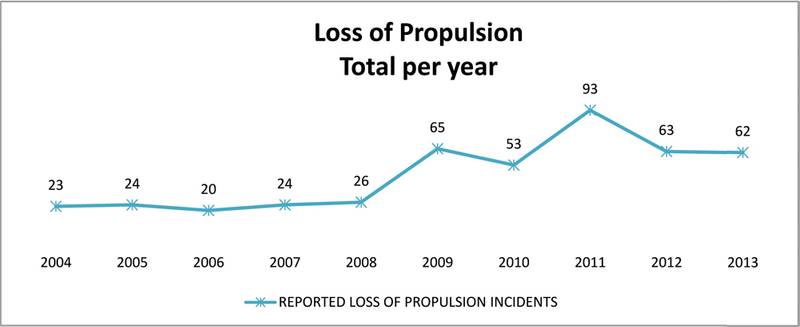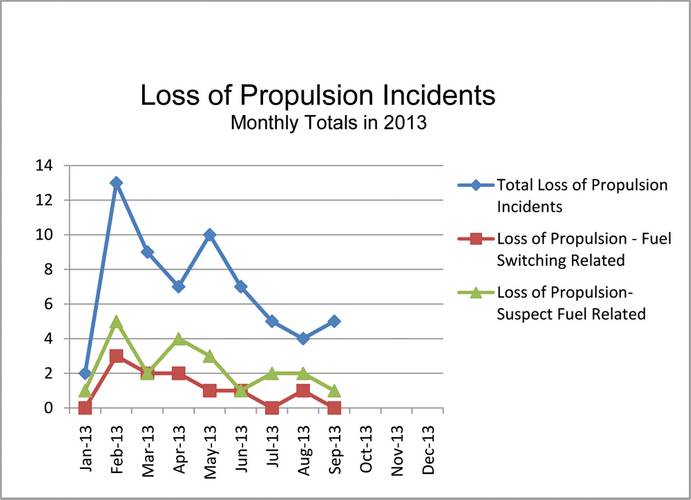A Closer Look at the Effects of ECAs
It’s a fact: Emission Control Areas (ECA) clean up the air that we breathe. It’s also a good bet that someday, ECAs might be the primary cause of dirtier water.
That’s because the physical act of switching from fuel oil to cleaner burning distillates on oceangoing craft is anything but a routine event for some vessels. But, don’t take our word for it – the State of California does a pretty good job of recordkeeping, and the numbers don’t lie.
It’s probably a good thing, then, that the U.S. Coast Guard in September published the long anticipated Non-tank Vessel Response Plan (NTVRP) and Other Response Plan regulations. Mandatory compliance will be required by January 30, 2014. This impacts self-propelled non-tank vessels of 400 gross tons or greater that operate in navigable waters of the United States and carry oil as fuel for main propulsion. The heightened level of preparedness should serve the industry well, especially given the troubling numbers coming out the Golden State. Workboats, salvage and response firms in greater numbers than ever will have to be at the ready.
The latest statistics chronicling Loss of Propulsion (LOP) incidents for deep draft vessels entering California waters show a recent (and marked) increase in this type of casualty. Indeed, and if the current trend continues, California could see its highest LOP totals since data on this type of thing began to be compiled in 2004. The numbers are important because California, unlike many places right now, requires ships to switch from fuel oil to cleaner burning distillates when they come within 24 miles of the California coast. But, other ECAs are coming, too. Beneath the raw data lurks troubling root causes and, perhaps, a glimmer of hope, as well.
The local California fuel switching rules have been in effect since 2009. And, although the requirement did not come into effect until July of that year, the number of LOP’s almost immediately tripled, as compared to the previous year. Today’s LOP numbers remain consistently high, as compared to pre-2009 rates, with the highest number seen in 2011, when it spiked all the way to 93 incidents. That metric was likely due to increased reporting requirements, closer scrutiny from California state regulatory personnel and better recordkeeping by the vessels themselves. Alarmingly, and although the numbers dipped precipitously last year (63), this year’s rate of incident reports could eclipse that seen in 2011.
LOP’s can occur because of poor fuel quality, incompetent engineroom staff, and/or poor engine maintenance. It’s a fact of life that the loss of sulphur in the distillates also equates to loss of lubricity in the fuel itself. Just as the automobile industry had to deal with the loss of lubricity when the elimination of lead occurred decades ago, today’s vessels are dealing with similar issues. The differences in viscosity of the two fuels add another variable to the issue. HFO is very forgiving of worn parts due the high viscosity of the fuel while the distillate isn’t forgiving at all. If crews are really keeping up their machinery as their paperwork attests, then why are we still experiencing this higher level of LOPs?
California records show more than 300 LOP incidents in CA waters since 2009, with fully one-third of those confirmed as being related to fuel switching procedures. The real danger is where these incidents are taking place – close in and often in pilot waters in proximity to shallow drafts and navigation hazards. More telling, perhaps, is that fully 79 vessels have failed to comply with local fuel switching regulations, citing “safety exemptions,” something that should give regulators everywhere pause when they contemplate future and stricter ECA zone(s). In the case of a safety exemption, the vessel remains burning HFO going into the berth and sometimes, going out, too. The practice of switching fuel sources on the fly involves risk and it requires skill. That as many as 100 ships in California waters in the past four years alone haven’t gotten it right is ample testimony to that.
Finally, a more obscure statistic – obtained from reliable sources who did not want to be identified for the purposes of this article – involves the fact that first time visitors to California waters experienced LOP failures when switching over to distillates as much as 30 percent of the time. Hence, like anything else, ship’s engineers get better at the procedure with practice. As ECAs come into effect all over the globe, these numbers loom all the more important. Also according to our source(s), the LOP numbers probably have as much to do with maintenance which, although immaculate paperwork often indicates is being done properly, is anything but. Still, and despite the fact that LOP’s have increased threefold since 2009, the Coast Guard still maintains that less than half are attributed to fuel. In January of 2015, and when the NAECA comes into play, ships will be switching 200 miles offshore California. So, in many respects, and no matter what you think of the California environmental lobby, the state is the perhaps the leading indicator of what could come next. On one hand, future LOP problems will likely occur some 200 miles offshore in deep water and with time to rectify problems before the vessel begins the all important inbound pilotage leg. That’s a good thing.
California’s recordkeeping gives insight into quantifying the issues which arise when one regulation, intended to obviate one problem, inadvertently causes another. Global classification society DNV said recently that as much as 50 percent of the world’s maritime fleet could be dual fuel-powered, as early as 2020. That’s an optimistic look at the future of LNG as a fuel, but also concedes that half of the global fleet will still be running on other fuels. As operators wean themselves from heavy fuel oil, fuel switching within so-called ECAs will remain fraught with danger.
Until we clean up the way we power the vessels that crisscross the seven seas, ECAs and fuel switching will remain as part of the environmental solution. This, and the new nontank rules mean more business for workboats, salvage and response folks. In the meantime, let’s just hope that cleaner air doesn’t eventually translate into a preventable casualty that means dirtier water.
The rest of the data can be seen on the State of California’s Fish & Wildlife website: https://nrm.dfg.ca.gov/FileHandler.ashx?DocumentID=38374&inline=true
(As published in the December 2013 edition of Marine News - www.marinelink.com)


















